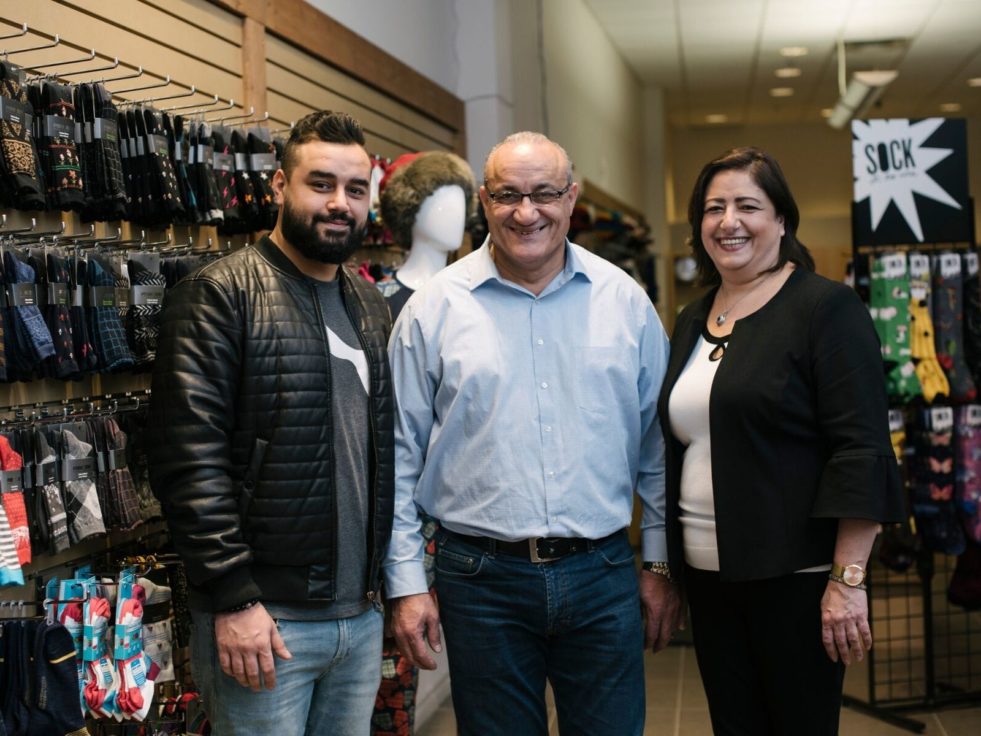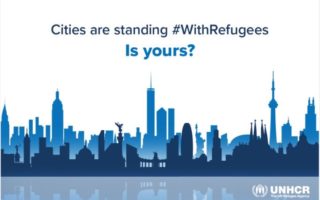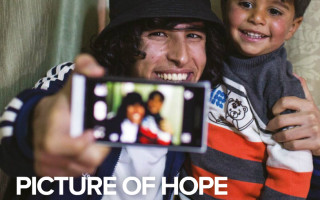
Ahmad Abed (centre) with son Eyad (left) and wife Roulah (right) seen at Our Sock Shoppe in Guelph, Ont.—a successful new venture for the Syrian family with entrepreneurial roots. Guelph signed the UNHCR Statement of Solidarity in June 2019, and is standing #WithRefugees like the Abed family. Ⓒ UNHCR/Hannah Yoon
By Jean-Nicolas Beuze, UNHCR Canada Representative
Most images of refugees profile life in camps, filled with makeshift tents made of plastic sheets. Women with infants are pictured in health clinics run by humanitarian organizations. Sometimes, images of children behind wire fences, separated from the rest of the population, are also publicized to describe how some host countries are reluctantly accepting refugees.
None of these images are forged. But they hide the reality that most displaced persons live in urban centres. Cities are the first port of call for two-thirds of those fleeing war, violence or persecution.
I witnessed this first-hand when working in Lebanon: almost one-third of the more than one million Syrian refugees had found refuge in Beirut, while hundreds of thousands of others were in or around the main cities in Lebanon. Often, two or three families who did not know each other before their exile would rent a flat together to share the costs. Many would live in abject poverty, finding shelter in unfinished buildings such as shopping malls or basements. With our help, children would be sent to the local public school. Patients would have to queue in front of public health centres with our ‘insurance card’ in hand to get access to nurses and medication. I remember many refugees voicing their fears of becoming invisible—dispersed in the masses of the busy Lebanese capital city.
The situation presented many challenges. It also offered incredible opportunities for refugees and for us, the UN Refugee Agency.
Many felt safer in a city than in remote locations. Some found jobs in the informal labour market. A greater variety of goods was more easily accessible, even if often not affordable. For us at UNHCR, it meant that our services supporting refugees also had benefits for the local people and the economy. We were able to increase the number and quality of health and education services for both communities at the same time—a way to give back to the impoverished Lebanese communities that had welcomed their Syrian sisters and brothers. Surprisingly to some, this helped to ensure social cohesion. The two communities living side by side would get to know each other, thus reducing fears of the unknown and tensions that usually result from not knowing your neighbours. When I visited our community centres, I saw both groups mingling, learning new skills or simply enjoying recreational activities together.
All over the world, most cities have now established programs to help newcomers settle and integrate. As cohorts of young children and mothers escape gang violence in Central America, it is heartening to see the efforts of the city of Guadalajara to welcome them. From providing emergency cash grants to setting up services to assist them in finding jobs, these measures promote inclusion and also discourage families from continuing their hazardous route to the U.S.
Some 200 cities around the world have now joined this global movement to show that they remain open and compassionate and strive for diversity and inclusion.
Here in Canada, we know that both asylum-seekers and resettled refugees converge towards cities—although not necessarily the “MTV trio,” Montreal-Toronto-Vancouver. Various cities, including Victoria, Guelph and Halifax have welcomed refugees over the last decades. As a testament to the role Canadian cities play in the welcoming and integration of refugees, seven cities joined our #Cities #WithRefugees campaign: Vancouver, Summerland, Port Moody, Prince Albert, Guelph, Gatineau and Rimouski. They joined Victoria, Saskatoon and Toronto that had expressed their solidarity last year. Some 200 cities around the world have now joined this global movement to show that they remain open and compassionate and strive for diversity and inclusion. It is a powerful message, especially when negative rhetoric scapegoating refugees far too often permeates public discourse. Concrete actions and symbols matter equally when taking a stand to protect and find solutions for the most vulnerable.





